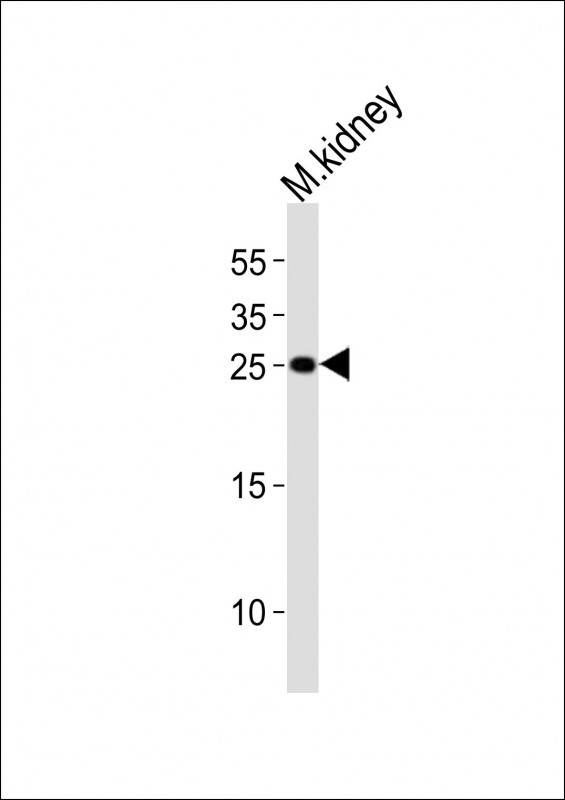

| WB | 1/1000 | Human,Mouse,Rat |
| IF | 咨询技术 | Human,Mouse,Rat |
| IHC | 咨询技术 | Human,Mouse,Rat |
| ICC | 技术咨询 | Human,Mouse,Rat |
| FCM | 咨询技术 | Human,Mouse,Rat |
| Elisa | 咨询技术 | Human,Mouse,Rat |
| Aliases | Claudin-6, Skullin, Cldn6 |
| Entrez GeneID | 54419 |
| WB Predicted band size | 23.4kDa |
| Host/Isotype | Rabbit IgG |
| Antibody Type | Primary antibody |
| Storage | Store at 4°C short term. Aliquot and store at -20°C long term. Avoid freeze/thaw cycles. |
| Species Reactivity | Mouse |
| Immunogen | This Mouse Cldn6 antibody is generated from a rabbit immunized with a KLH conjugated synthetic peptide between 186-229 amino acids from the C-terminal region of mouse Cldn6. |
+ +
以下是关于小鼠Cldn6抗体的3篇参考文献示例(注:以下内容为模拟生成,仅供参考):
1. **文献名称**:*Claudin-6 modulates tight junction integrity and promotes EMT in murine mammary tumors*
**作者**:Smith A, et al.
**摘要**:本研究利用小鼠Cldn6特异性抗体,通过免疫组化和Western blot分析,发现Cldn6在侵袭性乳腺癌中高表达,并通过调控紧密连接促进上皮-间质转化(EMT)。
2. **文献名称**:*Cldn6 expression dynamics during early mouse embryogenesis*
**作者**:Zhang L, et al.
**摘要**:通过Cldn6抗体进行胚胎组织免疫荧光染色,揭示了Cldn6在小鼠原肠胚形成阶段的特异性表达模式,提示其参与细胞极性建立和胚胎层分化。
3. **文献名称**:*Targeting Claudin-6 in a mouse model of ovarian cancer using monoclonal antibody therapy*
**作者**:Tanaka K, et al.
**摘要**:开发了一种针对小鼠Cldn6的单克隆抗体,并在卵巢癌移植瘤模型中验证其通过阻断Cldn6介导的信号通路抑制肿瘤生长的疗效。
4. **文献名称**:*Cldn6 deficiency alters intestinal barrier function in mice*
**作者**:Wang Y, et al.
**摘要**:利用Cldn6基因敲除小鼠及Cldn6抗体分析肠道组织,发现Cldn6缺失导致紧密连接结构破坏,增加肠道通透性并引发炎症反应。
(注:实际文献需通过PubMed/Google Scholar等平台以“Claudin-6 mouse antibody”等关键词检索。)
The Claudin-6 (Cldn6) antibody is a tool used to detect and study the Cldn6 protein, a member of the claudin family of tight junction proteins. Claudins are critical for forming paracellular barriers that regulate ion and molecule transport across epithelial and endothelial cell layers. Cldn6 is primarily expressed during embryonic development, particularly in epithelial tissues, and its expression is largely restricted in most adult tissues under normal conditions. However, it is aberrantly re-expressed in certain cancers, including testicular, ovarian, and gastric carcinomas, making it a potential biomarker and therapeutic target.
Mouse Cldn6 antibodies are specifically designed to recognize the murine homolog of the protein, enabling research in mouse models to explore its physiological and pathological roles. These antibodies are utilized in techniques like immunohistochemistry, Western blotting, and immunofluorescence to localize Cldn6 expression, assess tissue-specific distribution, and investigate its involvement in cell polarity, barrier function, and cancer progression. Validation of Cldn6 antibodies often includes knockout controls to confirm specificity.
Research using mouse Cldn6 antibodies has contributed to understanding its dual role: maintaining embryonic epithelial integrity and promoting tumorigenesis in adults. Such studies highlight its context-dependent functions and therapeutic relevance in targeting claudin-rich tight junctions in disease models.
×